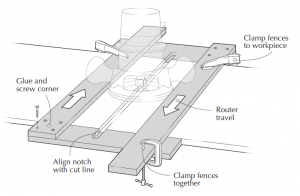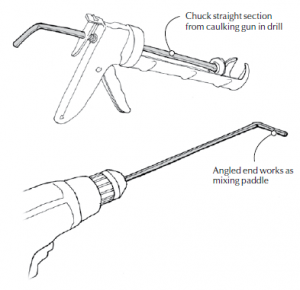We may receive a commission when you use our affiliate links. However, this does not impact our recommendations.
“Tricks of the Trade” is one of the most well-liked sections in our magazine. Here are three of these reader-submitted woodworking tips from the many we have published in recent history. Enjoy! And if you like what you see, consider a subscription to the magazine. It’s the one of the best ways to build a relationship with us and build your knowledge base.
Tell us some more of your favorite tricks in the comments section at the bottom of this post!
–Dan Farnbach
Adjustable Dado-routing Jig
 I wanted to rout some shelf dados, but I didn’t have the correct-size bit for the job. Fortunately my dad stopped by and, as usual, had the answer to my problem. We cobbled up a couple L-shaped wooden fences from 3″-wide straight scraps, squaring each of the units carefully before gluing and screwing them together at the corners. After laying out the dado on the stock, I clamped the two fences together against the workpiece as shown, with the two long fences spaced at the appropriate distance from each other.
I wanted to rout some shelf dados, but I didn’t have the correct-size bit for the job. Fortunately my dad stopped by and, as usual, had the answer to my problem. We cobbled up a couple L-shaped wooden fences from 3″-wide straight scraps, squaring each of the units carefully before gluing and screwing them together at the corners. After laying out the dado on the stock, I clamped the two fences together against the workpiece as shown, with the two long fences spaced at the appropriate distance from each other.
Pushing the router forward against the left-hand fence, then pulling it back against the right-hand fence, yields the exact width of cut in two passes, as long as you’re using a bit that’s at least half the width of the desired cut.
–Doug Corman
Missoula, Montana
Clean, Easy Epoxy – the Pastry Chef Way
For mixing two-part liquid epoxy, I squeeze the proper amounts of resin and hardener into the corner of a strong small plastic bag, then knead the bag to mix the two parts together. Pinch the mixture toward the corner of the bag and puncture or cut an appropriately sized hole right at the very corner. You can now squeeze the mixed epoxy through the hole directly onto the intended surface with fine control and without getting glue on your fingers. Works great!
–Ron Dolittle
Denver, Colorado
Paint Mixer from Broken Caulking Gun
 When I needed to mix two different paint colors to create a new one, I came up with the idea of removing the rod from my broken caulking gun and mounting it to my drill to serve as a paint stirrer. The straight section fit into my drill chuck without modification, while the angled end served beautifully as a rotating mixing paddle. I used my cordless drill to power the mixer, but a corded drill running at low speed would work fine.
When I needed to mix two different paint colors to create a new one, I came up with the idea of removing the rod from my broken caulking gun and mounting it to my drill to serve as a paint stirrer. The straight section fit into my drill chuck without modification, while the angled end served beautifully as a rotating mixing paddle. I used my cordless drill to power the mixer, but a corded drill running at low speed would work fine.
–Bob Kelland
St. John’s, Newfoundland
Here are some supplies and tools we find essential in our everyday work around the shop. We may receive a commission from sales referred by our links; however, we have carefully selected these products for their usefulness and quality.








